Research Newsletter | Summer 2022
FEATURED ARTICLE
Get to Know Dr. Mark Oyama
Mark A. Oyama, DVM, MSCE, DACVIM-Cardiology was recently named the Chair of the Department of Clinical Sciences and Advanced Medicine. Dr. Oyama also serves as the Charlotte Newton Sheppard Endowed Professor of Medicine and Professor of Cardiology and has been a member of the CSAM faculty since 2005. From a relatively young age, Dr. Oyama knew he wanted to be a veterinarian, but the path to specialization in cardiology and a career as a clinical researcher was one that he never anticipated.
When Dr. Oyama entered veterinary school at the University of Illinois in 1990, he was determined to become an equine veterinarian. Throughout his adolescence, Dr. Oyama completed in dressage and 3-day eventing with his Appendix Quarter Horse, Gandalf the Wiz. He spent many summers travelling dusty rural roads with the local equine veterinarian and working as a barn hand in return for free lessons. Dr. Oyama’s career path dramatically changed after taking Dr. David Sisson’s small animal cardiology course during his 3rd year of veterinary school. Mentored by Dr. Sisson, Dr. Oyama found himself heading to The Animal Medical Center in New York City for a rotating small animal internship followed by a cardiology residency at the University of California at Davis. Dr. Oyama successfully achieved board certification by the American College of Veterinary Internal Medicine, Specialty of Cardiology (ACVIM-Cardiology) in 1998. Upon leaving his residency, Dr. Oyama found himself drawn by the siren’s song of private practice and took a position at a specialty referral hospital in Portland, Oregon. Dr. Oyama was fully enjoying the idyllic Pacific northwest lifestyle with his Golden Retriever when one day his phone rang, and David Sisson asked if he would be interested in a faculty position at the University of Illinois. Dr. Oyama ended up serving on the Illinois’ faculty from 2000 to 2005, during which time he learned how to be a clinical researcher and teacher. The process, as anyone who has had a similar experience will know, is slow and incremental, and in need of dedicated mentoring from senior faculty. In 2005, Dr. Oyama was promoted to Associate Professor and shortly thereafter elected to move from Illinois and join Penn Vet. In the 17 years since, Dr. Oyama has made clinical research one of his most important missions. Over time, he settled into a few specific avenues of inquiry, namely the clinical and molecular pathology of myxomatous mitral valve disease (MMVD) in the dog, diagnostic and prognostic utility of cardiac biomarkers, such NT-proBNP, and development and testing of new interventions and medications for heart disease.
These investigations have led to many satisfying discoveries, advances, and collaborations across the biomedical community. Dr. Oyama was the first to report on the association of serotonin (5HT) signaling and MMVD in the dog, which currently is one of leading hypothesis around progression of Myxomatous Mitral Valve Degeneration in both the dog and human. His interest in 5HT has led to collaborations with Dr. Robert Levy at Children’s Hospital of Philadelphia and Dr. Giovanni Ferrari at Columbia University and publications involving the translational 5HT mechanisms of disease in journals such as Cardiovascular Pathology and Journal of Cell and Molecular Biology. Dr. Oyama was fortunate to lead and participate in many of the biomarker studies and drug trials that resulted in commercially available NT-proBNP tests in dogs and cats and the approval of new diuretics for heart failure in dogs including torsemide in the European Union. Recently, Dr. Oyama has been interested in changing how diuretics are used for acute and chronic heart failure. The trend in both veterinary and human medicine is to utilize more quantitative measures such as urine sodium rather than the current practice of relying solely on the presence or absence of frank congestion to guide dosing decisions. In collaboration with Dr. Jeff Testani, formerly of Penn Medicine and now at Yale University, Dr. Oyama and colleagues took newly described metrics of responsiveness for human heart failure patients and validated them for use in dogs. The shift to more quantitative measures facilitates determination of diuretic responsiveness and resistance and can lead to better outcomes.
Dr. Oyama credits much of his career thus far on the clinical research mission, which has opened doors and benefited him in many direct and indirect ways. His reputation as an investigator has elevated his standing within his specialty, enabling him to serve on various committees and positions of leadership, including as the ACVIM-Cardiology president. The visibility afforded by clinical research has made him a key opinion leader and allowed him to garner invitations to speak at meetings all over the world. His work has received recognition from the American Kennel Club and funding from animal health foundations, the NIH, and from industry. It has also attracted partnerships with industry wherein he has the ability to influence the development and direction of new therapies and diagnostics. At some point in time, every major veterinary pharmaceutical company has sought out Dr. Oyama’s advice. One company’s R&D division brought in Dr. Oyama to be their “closer” during a critical meeting with executives about the potential value of a new heart failure product and whether development would go forward (It did!).
Dr. Oyama notes that this is a particularly exciting time to be working in veterinary cardiology. Advances in the understanding of the pathophysiology of heart disease are rapidly occurring, and along with them come potential new therapies. Dr. Oyama is currently working on several strategies, including an entirely new type of diuretic for heart failure and new means to suppress the renin-angiotensin-aldosterone system. This work is squarely aimed at bringing these advances to the veterinary field and for the benefit of veterinary patients. In his new role as Chair of CSAM, Dr. Oyama hopes to facilitate the clinical research mission of its faculty members. He is particularly interested in developing new funding sources, increasing research efficiency and return on investment, fostering collaborations with intramural and extramural research groups that align with the Department’s mission, and helping junior faculty reach their research goals in the same way that his own mentors helped Dr. Oyama reach his.
Latest Research
Highlighted News
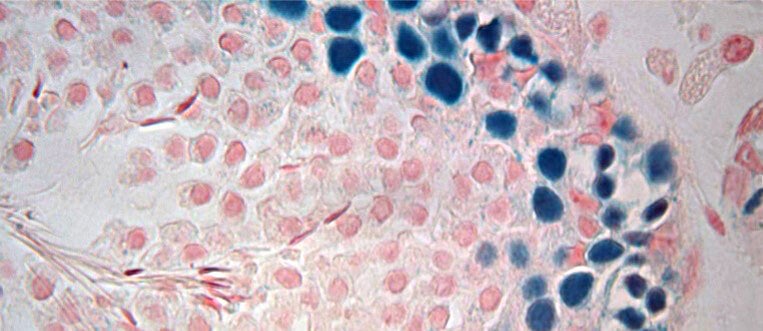
Frozen testicular tissue still viable after 20 years (link is external)
A new study in rats has shown that male testis tissue that is cryopreserved can be reimplanted after more than 20 years and will go on to make viable sperm.
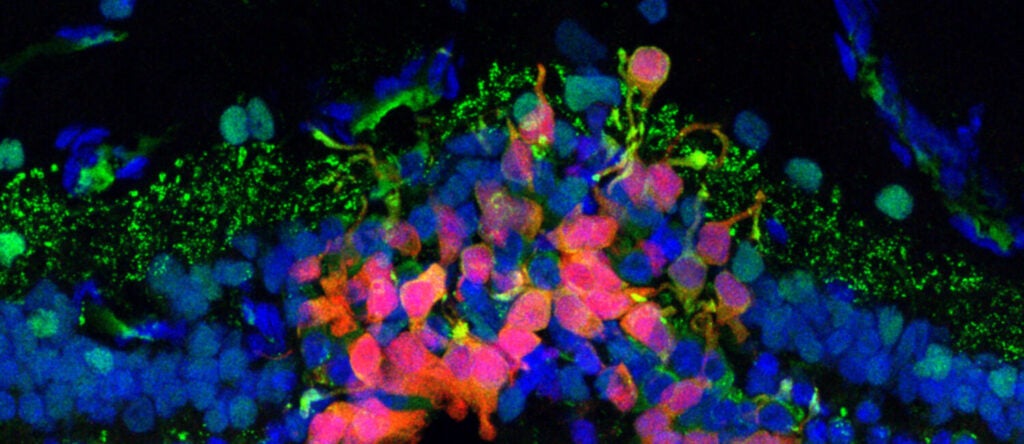
Progress toward a stem cell–based therapy for blindness (link is external)
A multi-institutional effort led by researchers at Penn Vet is taking steps to develop an effective technique to regenerate photoreceptors cells and restore sight in people with vision disorders.
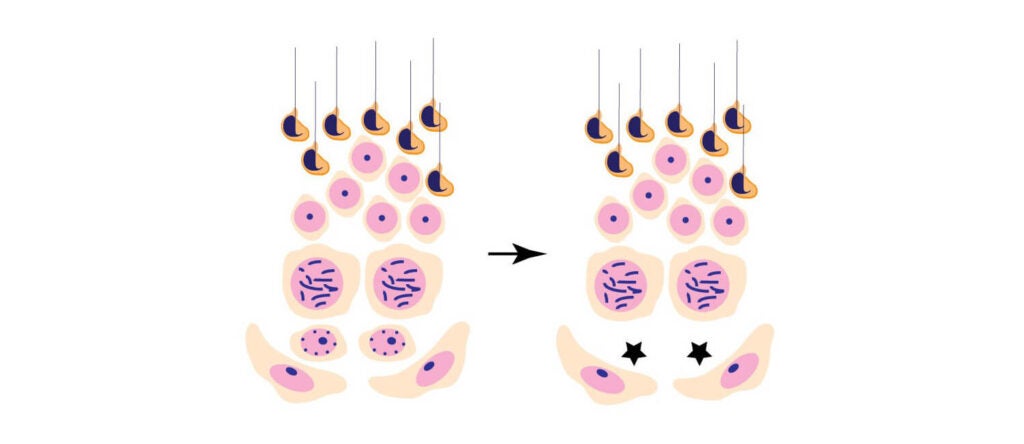
A newly identified stem cell regulator enables lifelong sperm production (link is external)
Research led by Dr. Jeremy Wang has discovered that the enzyme DOT1L, a stem cell renewal factor, is essential for mice to produce sperm throughout their adult lives.
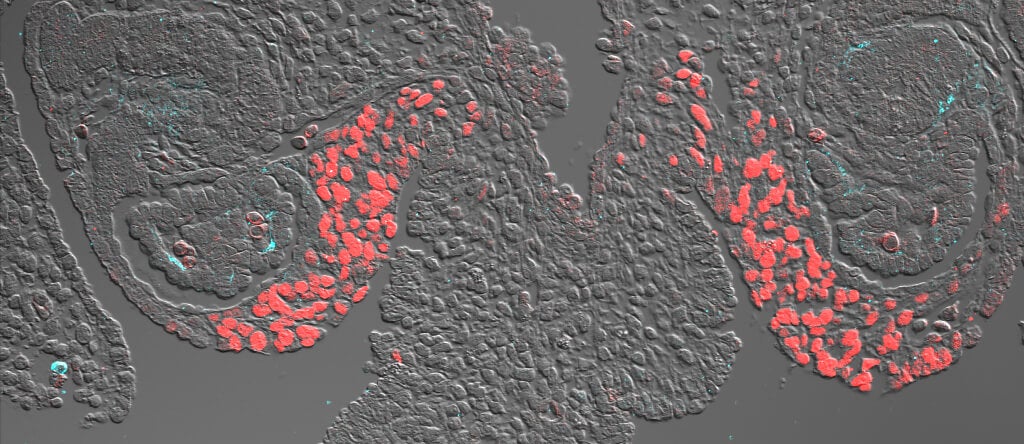
Elucidating the developmental origin of life-sustaining adrenal glands (link is external)
Research led by the School of Veterinary Medicine reveals that adrenal development proceeds differently in humans than it does in mice.
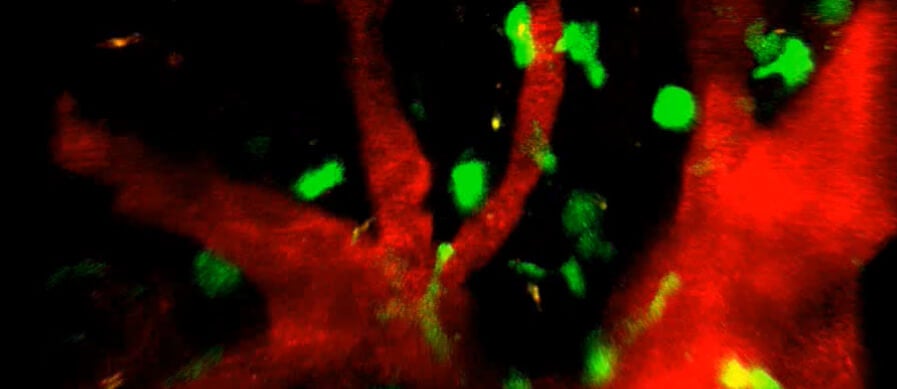
Regulating the regulators of the immune system (link is external)
Research led by Penn Vet scientists reveals a new layer of complexity with which the immune system finds a balance between controlling pathogens and protecting healthy tissue.
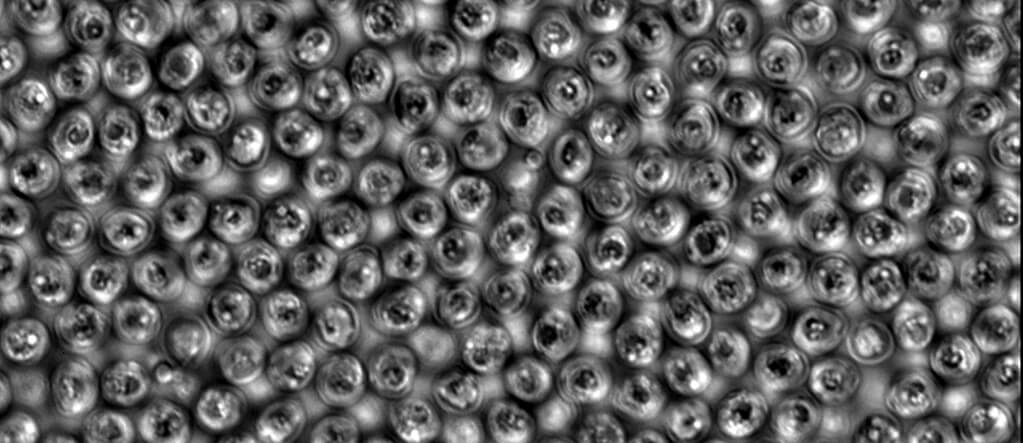
Revising the lifecycle of an important human parasite (link is external)
Researchers from Dr. Boris Striepen’s lab tracked Cryptosporidium in real time, creating a new paradigm for how the widespread parasite reproduces in a host.
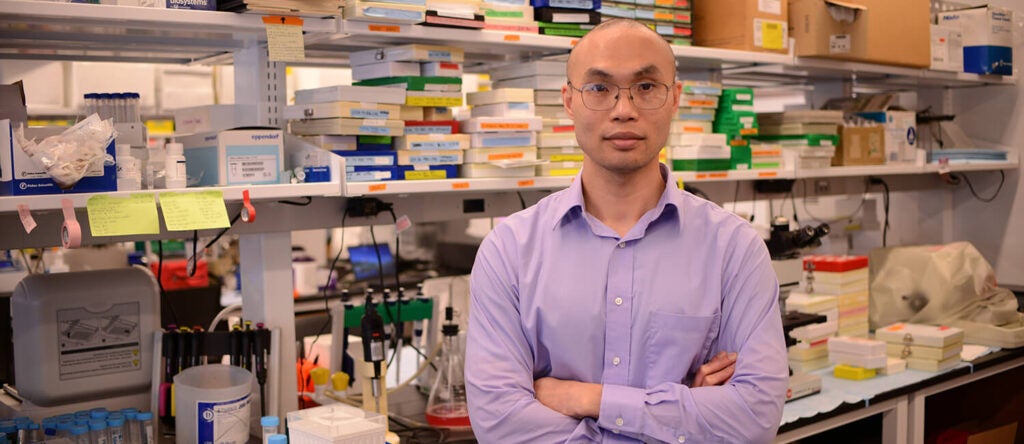
The Institute for Infectious and Zoonotic Diseases at the University of Pennsylvania’s School of Veterinary Medicine to Fund Postdoctoral Fellowship
The postdoctoral fellowship will support scientists conducting research related to the biology of infectious disease.
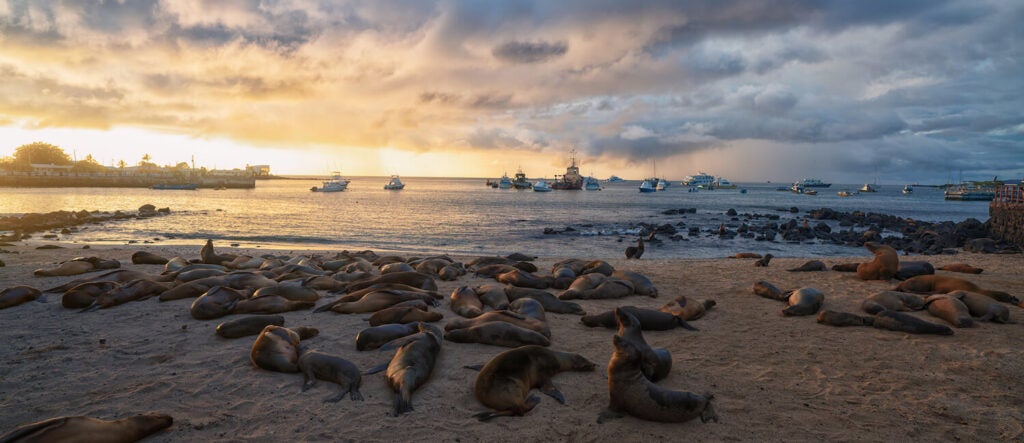
In the Galápagos, training community scientists to monitor water quality (link is external)
Both dense human populations and a plethora of wildlife can pose a challenge to marine and public health in the Galápagos Islands. With portable, user-friendly PCR technology, Penn faculty and…
The first canine C-11 positron emission tomography (PET) scans at PennPET Explorer were completed by Brian Flesner, DVM, MSc, DACVIM and the Penn Vet Veterinary Clinical Investigations Center (VCIC) in collaboration with other University partners. PET is a common imaging modality used to detect and monitor cancer in people. Recently, researchers at Penn Vet have collaborated with both industry, intramural, and government agencies to make PET scans available for animals at Penn. Penn Vet’s oncology group has joined a collaborative effort to harmonize PET imaging across the Comparative Oncology Trials Consortium institutions through the National Cancer Institute. Penn is one of only six COTC institutions with PET capabilities.
Raghavi Sudharsan is a vision scientist with 10 years of experience in cell and molecular biology applied to the field of inherited retinal diseases. She joined Dr. William Beltran’s laboratory at Penn Vet in 2012 as a postdoctoral researcher immediately after completion of her PhD in Molecular, Cellular and Developmental Biology from University of Kansas. She was promoted to the rank of Research Associate in 2017, and then to Senior Research Investigator in 2019. In January 2022, she joined the Department of Clinical Sciences & Advanced Medicine as an Assistant Professor, Research Track, within the Division of Experimental Retinal Therapies. Her research focus has been aimed at understanding the mechanisms of disease for inherited retinal degenerations and identifying common degenerative pathways that can be targeted for developing gene-agnostic therapies. She is also developing next generation promoters and AAV vectors for Penn Vet’s retinal gene therapy program.
Caroline Sobotyk is an Assistant Professor of Clinical Parasitology in the Department of Pathobiology. Dr. Sobotyk is originally from Porto Alegre, Brazil. She completed her DVM in 2013 at the Universidade Federal de Santa Maria (UFSM) in Santa Maria, RS, Brazil and earned a MSc (2015) and PhD (2019) degree in Veterinary Parasitology from the same institution. In 2019, Dr. Sobotyk accepted a postdoctoral position at Texas A&M University (TAMU), while also undertaking her veterinary clinical parasitology residency with the National Center for Veterinary Parasitology. Her research focuses on the improvement and development of conventional and molecular diagnostic techniques for detecting parasitic infections with the aim to improve the general health and well-being of domestic and wild animals and better understand treatment and prevention strategies.New Bolton Center as an Assistant Professor of Large Animal Surgery in the Department of Clinical Studies. Her research is focused on understanding the relationship between subchondral bone and joint health. She is interested in the role of bone marrow lesions and has focused on the development of translational experimental models and optimization of volumetric imaging for the detection of changes within the subchondral bone.ine cognitive dysfunction.
Honors & Achievements
P. Jeremy Wang, MD, PhD, Named Ralph L. Brinster President’s Distinguished Professor at Penn Vet
The awarding of a named, endowed professorship is the highest honor bestowed upon a faculty member at the University of Pennsylvania and reflects a commitment to scientific discovery, mentorship, and…
University of Pennsylvania’s School of Veterinary Medicine Awarded Nearly $1 Million to Increase Efficiency of Dairy Herds and Reduce Methane Emissions
Principal investigator Dipti Pitta, MVSc, PhD, receives grant from the USDA’s National Institute of Food and Agriculture to build upon pioneering research on rumen microbiota and nutrient utilization.
The University of Pennsylvania’s School of Veterinary Medicine Announces Infectious and Zoonotic Disease Pilot Awards
Awards represent the Institute for Infectious and Zoonotic Diseases’ long-term vision of supporting research that advances understanding of infectious diseases.
Liz Lennon Receives NIH Council on One Health Alliance-Clinical and Translational Science Award
Elizabeth M. Lennon, DVM, PhD and her team were recently awarded a NIH Council on One Health Alliance-Clinical and Translational Science Award (COHA-CTSA). These highly competitive awards provide residency-trained veterinarians a two-year intensive laboratory-based translational research fellowship.
This fall, Dr. Lennon’s team will welcome Dr. Hyun-tae Kim, DVM, MS, who recently completed a nutrition residency at Cornell University. Dr. Kim will be studying mechanisms of diet-induced immunomodulation in inflammatory intestinal diseases in dogs and humans.
The COHA review heavily weights the expertise and relationships within the mentoring group, and in this case, the group consisting of Dr. Lennon, Dr. Dan Beiting, Dr. De’Broski Herbert, and Dr. Nicole Maloney Belle (PSOM) was a major strength.
Four Penn Vet Faculty Win McCabe Fund Awards
Congratulations are in order for four Penn Vet faculty members who secured 2022-2023 pilot awards from The Thomas B. McCabe and Jeannette E. Laws McCabe Fund. The winning faculty members and their projects are:
Candice P. Chu, DVM, PhD, DACVP: Comparison of sample volume and isolation methods for urinary extracellular vesicles derived microRNA for transcriptomic biomarker studies in cats with chronic kidney disease
Maureen A. Griffin, DVM: Sentinel lymph node mapping for canine apocrine gland anal sac adenocarcinoma
Anna M. Massie, DVM: Assessment of microdamage and peri-prosthetic healing related to zinc-coated implants in a rabbit femur model
Raghavi Sudharsan, PhD: Functional characterization of a novel prolactin isoform in inherited retinopathies using a knockdown approach
Lengner Lab’s Kamen Simeonov Wins 2022 Saul Winegrad Award for Outstanding Dissertation
Kamen Simeonov, MD, PhD, of the Lengner Laboratory, is the winner of a 2022 Saul Winegrad Award for Outstanding Dissertation. This award was established in 1995 to recognize a dissertation of outstanding quality which makes a significant contribution to biomedical science. Selections are made at the graduate group level. Dr. Simeonov’s dissertation was selected from among 16 outstanding nominees in the Cell and Molecular Biology Graduate Group.
Racing Medication and Testing Consortium to Fund Postdoctoral Fellowship for Penn Vet Equine Pharmacology Research Lab’s Bethany Keen
Bethany Keen, PhD, of the Penn Vet Equine Pharmacology Research Laboratory, has been awarded funding for her postdoctoral fellowship from the Racing Medication and Testing Consortium (RMTC). Her funded proposal entitled, Detection of bisphosphonates using metabolomics, will be conducted under the supervision of Mary A. Robinson, VMD, PhD, DACVCP.
Select Publications and Grants
Read the latest scholarly publication and grant information from Penn Vet researchers.
Badiei A, Beltran WA, and Aguirre GD. Altered transsulfuration pathway enzymes and redox homeostasis in inherited retinal degenerative diseases. Experimental Eye Research 2022;215:108902.
Buhl R, Hesselkilde EM, Carstensen H, Hopster‐Iversen C, van Loon G, Decloedt A, Van Steenkiste G, Marr CM, Reef VB, and Schwarzwald CC. Atrial fibrillatory rate as predictor of recurrence of atrial fibrillation in horses treated medically or with electrical cardioversion. Equine Veterinary Journal 2022.
Cameron AD, Even KM, Linardi RL, Berglund AK, Schnabel LV, Engiles JB, and Ortved KF. Adeno-associated virus-mediated overexpression of interleukin-10 affects the immunomodulatory properties of equine bone marrow-derived mesenchymal stem cells. Human Gene Therapy 2021;32:907-918.
Castejón-González AC, Stefanovski D, and Reiter AM. Etiology, clinical presentation, and outcome of mandibular fractures in immature dogs treated with non-invasive or minimally invasive techniques. Journal of Veterinary Dentistry 2022;39:78-88.
Chalifoux NV, Rizzo K, Stefanovski D, Weinstein NM, and Silverstein DC. Clinical application of the StatSensor and StatSensor Xpress point-of-care creatinine measurement devices in dogs. Veterinary Clinical Pathology 2022;n/a.
Chalifoux NV, Silverstein DC, Page B, and Fudge JM. Assessment of changes in intra-abdominal pressure and abdominal perfusion pressure in late-term pregnant queens undergoing elective ovariohysterectomy. American Journal of Veterinary Research 2022;83:ajvr.22.02.0023.
Chen T, Wang C, Cui Z, Liu X, Jiang J, Yin J, Feng H, and Dou Z. COVID-19 affected the food behavior of different age groups in Chinese households. Plos one 2021;16:e0260244.
Cheng K, Seita Y, Moriwaki T, Noshiro K, Sakata Y, Hwang YS, Torigoe T, Saitou M, Tsuchiya H, Iwatani C, Hosaka M, Ohkouchi T, Watari H, Umazume T, and Sasaki K. The developmental origin and the specification of the adrenal cortex in humans and cynomolgus monkeys. Science Advances 2022;8:eabn8485.
Chua K-P, Perrone J, Redding LE, Brummett CM, Bahl S, and Bohnert AS. Trends in the number of patients linked to potential vet-shopping behavior in the United States (2014-2019). American Journal of Veterinary Research 2022;83:147-152.
Chung ST, Katz LEL, Stettler-Davis N, Shults J, Sherman A, Ha J, Stefanovski D, Boston RC, Rader DJ, and Magge SN. The relationship between lipoproteins and insulin sensitivity in youth with obesity and abnormal glucose tolerance. The Journal of Clinical Endocrinology & Metabolism 2022;107:1541-1551.
Cianci JM, Wulster KB, Richardson DW, Stefanovski D, and Ortved KF. Computed tomographic assessment of fracture characteristics and subchondral bone injury in Thoroughbred racehorses with lateral condylar fractures and their relationship to outcome. Veterinary Surgery 2022;51:426-437.
Cole SD, Perez-Bonilla D, Hallowell A, and Redding LE. Carbapenem prescribing at a veterinary teaching hospital before an outbreak of carbapenem-resistant Escherichia coli. Journal of Small Animal Practice 2022;63:442-446.
Douglas H, Welsh S, and Barr C. Clinical techniques in veterinary dermatology: regional anaesthesia of the canine and feline distal limb. Veterinary Dermatology 2021;32:90-e17.
English ED, Guérin A, Tandel J, and Striepen B. Live imaging of the Cryptosporidium parvum life cycle reveals direct development of male and female gametes from type I meronts. PLOS Biology 2022;20:e3001604.
Flesner BK, Torres BT, Hutcheson KD, Rindt H, Zalcman AR, and Maitz CA. A pilot study of cancer-induced bone pain using validated owner questionnaires, serum N-telopeptide concentration, kinetic analysis, and PET/CT. Frontiers in Veterinary Science 2021;8.
Flory A, Kruglyak KM, Tynan JA, McLennan LM, Rafalko JM, Fiaux PC, Hernandez GE, Marass F, Nakashe P, Ruiz-Perez CA, Fath DM, Jennings T, Motalli-Pepio R, Wotrang K, McCleary-Wheeler AL, Lana S, Phillips B, Flesner BK, Leibman NF, LaDue T, Tripp CD, Coomber BL, Woods JP, Miller M, Aiken SW, Wolf-Ringwall A, Borgatti A, Kraska K, Thomson CB, Kosanovich Cahalane A, Murray RL, Kisseberth WC, Camps-Palau MA, Floch F, Beaudu-Lange C, Klajer-Peres A, Keravel O, Fribourg-Blanc L-A, Mazetier PC, Marco A, McLeod MB, Portillo E, Clark TS, Judd S, Feinberg CK, Benitez M, Runyan C, Hackett L, Lafey S, Richardson D, Vineyard S, Tefend Campbell M, Dharajiya N, Jensen TJ, van den Boom D, Diaz LA, Jr., Grosu DS, Polk A, Marsal K, Hicks SC, Lytle KM, Holtvoigt L, Chibuk J, Chorny I, and Tsui DWY. Clinical validation of a next-generation sequencing-based multi-cancer early detection “liquid biopsy” blood test in over 1,000 dogs using an independent testing set: The CANcer Detection in Dogs (CANDiD) study. PLOS ONE 2022;17:e0266623.
Frosth S, Morris ERA, Wilson H, Frykberg L, Jacobsson K, Parkhill J, Flock J-I, Wood T, Guss B, Aanensen DM, Boyle AG, Riihimäki M, Cohen Noah D, and Waller AS. Conservation of vaccine antigen sequences encoded by sequenced strains of Streptococcus equi subsp. equi. Equine Veterinary Journal 2022;n/a.
Gaab T, Nogay E, and Pierdon M. Development and progression of shoulder lesions and their influence on sow behavior. Animals 2022;12:224.
Goszczynski DE, Tinetti PS, Choi YH, Hinrichs K, and Ross PJ. Genome activation in equine in vitro–produced embryos. Biology of Reproduction 2021;106:66-82.
Goszczynski DE, Tinetti PS, Choi YH, Ross PJ, and Hinrichs K. Allele-specific expression analysis reveals conserved and unique features of preimplantation development in equine ICSI embryos†. Biology of Reproduction 2021;105:1416-1426.
Gradilla SM, Balakrishnan A, Silverstein DC, Pratt CL, Fletcher DJ, and Wolf JM. Owner experiences with and perceptions of owner‐witnessed CPR in veterinary medicine. Journal of Veterinary Emergency and Critical Care 2022;32:322-333.
Gray AP, Sato Y, Miyadera K, and Aguirre GD. Novel insights into chorioretinal and juxtapapillary colobomas by optical coherence tomography. Vet Ophthalmol 2022.
Guan Y, Lin H, Leu NA, Ruthel G, Fuchs SY, Busino L, Luo M, and Wang PJ. SCF ubiquitin E3 ligase regulates DNA double-strand breaks in early meiotic recombination. Nucleic acids research 2022;50:5129-5144.
Haughan JE, Missanelli JR, You Y, Stefanovski D, Soma LR, and Robinson MA. Pharmacokinetics of glaucine after intravenous and oral administrations and detection of systemic aporphine alkaloids after ingestion of tulip poplar shavings in horses. Journal of Veterinary Pharmacology and Therapeutics 2022;45:273-282.
Haunhorst FR, Hopster K, Schmicke M, Bienert-Zeit A, and Kästner S. Clinical effect of buprenorphine or butorphanol, in combination with detomidine and diazepam, on sedation and postoperative pain after cheek tooth extraction in horses. The Canadian veterinary journal = La revue veterinaire canadienne 2022;63:39-46.
Hopster K and Driessen B. Pharmacology of the equine foot: Medical pain management for laminitis. Veterinary Clinics of North America: Equine Practice 2021;37:549-561.
Hopster K, Watkins AR, and Hurcombe SD. Comparison of cervical epidural morphine with intravenous morphine administration on antinociception in adult horses using thermal threshold testing. Veterinary Anaesthesia and Analgesia2022;49:417-422.
Klein CE, Bramlage LR, Stefanovski D, Ruggles AJ, Embertson RM, and Hopper SA. Comparative results of 3 treatments for medial femoral condyle subchondral cystic lesions in Thoroughbred racehorses. Veterinary Surgery 2022;51:455-463.
Kranz VA, Horback KM, Parsons TD, and Pierdon MK. Sow behavior during introduction to a large dynamic group is influenced by familiarity and method. Applied Animal Behaviour Science 2022;250:105624.
Kupratis ME, Gure AE, Benson JM, Ortved KF, Burris DL, and Price C. Comparative tribology II–Measurable biphasic tissue properties have predictable impacts on cartilage rehydration and lubricity. Acta Biomaterialia 2022;138:375-389.
Lin H, Cheng K, Kubota H, Lan Y, Riedel SS, Kakiuchi K, Sasaki K, Bernt KM, Bartolomei MS, Luo M, and Wang PJ. Histone methyltransferase DOT1L is essential for self-renewal of germline stem cells. Genes & Development 2022.
Ling L, Li F, Yang P, Oates RD, Silber S, Kurischko C, Luca FC, Leu NA, Zhang J, and Yue Q. Genetic characterization of a missense mutation in the X-linked TAF7L gene identified in an oligozoospermic man. Biology of Reproduction 2022.
Luethy D, Robinson MA, Stefanovski D, Haughan J, Torcivia C, Kowalski A, Ford M, You Y, Missanelli J, and Slack J.Pharmacokinetics and pharmacodynamics of oral and intravenous metoprolol tartrate in clinically healthy horses. Journal of Veterinary Pharmacology and Therapeutics 2022;45:177-187.
Martin KH, Redding LE, and Boyle AG. Factors influencing veterinarian opinion on reporting of equine strangles in the United States. Journal of Equine Veterinary Science 2022;114:103947.
Norquest CJ, Maitz CA, Keys DA, Moore M, Bryan JN, Ehling TJ, Lattimer JC, and Flesner BK. Fracture rate and time to fracture in dogs with appendicular osteosarcoma receiving finely fractionated compared to coarsely fractionated radiation therapy: A single institution study. Veterinary Medicine and Science 2022;8:1013-1024.
Perry JA, Shallberg L, Clark JT, Gullicksrud JA, DeLong JH, Douglas BB, Hart AP, Lanzar Z, O’Dea K, Konradt C, Park J, Kuchroo JR, Grubaugh D, Zaretsky AG, Brodsky IE, Malefyt RdW, Christian DA, Sharpe AH, and Hunter CA. PD-L1–PD-1 interactions limit effector regulatory T cell populations at homeostasis and during infection. Nature Immunology 2022;23:743-756.
Pitta D, Indugu N, Narayan K, and Hennessy M. Symposium review: Understanding the role of the rumen microbiome in enteric methane mitigation and productivity in dairy cows. Journal of Dairy Science 2022.
Redding LE, Berry AS, Indugu N, Huang E, Beiting DP, and Pitta D. Gut microbiota features associated with Clostridioides difficile colonization in dairy calves. PLOS ONE 2021;16:e0251999.
Redding LE, Elzer EJ, and Ortved KF. Effects of regional limb perfusion technique on concentrations of antibiotic achieved at the target site: A meta-analysis. PLOS ONE 2022;17:e0265971.
Redding LE, Tu V, Abbas A, Alvarez M, Zackular JP, Gu C, Bushman FD, Kelly DJ, Barnhart D, Lee JJ, and Bittinger KL. Genetic and phenotypic characteristics of Clostridium (Clostridioides) difficile from canine, bovine, and pediatric populations. Anaerobe 2022;74:102539.
Ripolles-Garcia A, Dolgova N, Phillips MJ, Savina S, Ludwig AL, Stuedemann SA, Nlebedum U, Wolfe JH, Garden OA, Maminishkis A, Amaral J, Bharti K, Gamm DM, Aguirre GD, and Beltran WA. Systemic immunosuppression promotes survival and integration of subretinally implanted human ESC-derived photoreceptor precursors in dogs. Stem Cell Reports 2022.
Romano MC, Francis KA, Janes JG, Poppenga RH, Filigenzi MS, Stefanovski D, and Gaskill CL. Determining an approximate minimum toxic dosage of diphacinone in horses and corresponding serum, blood, and liver diphacinone concentrations: A pilot study. Journal of Veterinary Diagnostic Investigation 2022;34:489-495.
Scharf A, Navas de Solis C, Sampson SN, Glass K, and Watts AE. Suspensory ligament size does not change after plantar fasciotomy and neurectomy of the deep branch of the lateral plantar nerve by ultrasonographic assessment. Veterinary Surgery 2022;51:259-269.
Torcivia C, and McDonnell S. Efficacy of lidocaine topical solution in reducing discomfort reaction of horses to intramuscular vaccination. Animals 2022;12:1659.
Whelan EC, Yang F, Avarbock MR, Sullivan MC, Beiting DP, and Brinster RL. Reestablishment of spermatogenesis after more than 20 years of cryopreservation of rat spermatogonial stem cells reveals an important impact in differentiation capacity. PLoS Biol 2022;20:e3001618.
Zhang H, Yu P, Tomar VS, Chen X, Atherton MJ, Lu Z, Zhang H-G, Li S, Ortiz A, Gui J, Leu NA, Yan F, Blanco A, Meyer-Ficca ML, Meyer RG, Beiting DP, Li J, Nunez-Cruz S, O’Connor RS, Johnson LR, Minn AJ, George SS, Koumenis C, Diehl JA, Milone MC, Zheng H, and Fuchs SY. Targeting PARP11 to avert immunosuppression and improve CAR T therapy in solid tumors. Nature Cancer 2022.
Jorge Alvarez
Stanford University
Dysregulation within the brain-immune axis in the 22q11.2 deletion syndrome
05/01/22—04/30/23
$150,000
Montserrat C. Anguera
NIH R21
Sex-dependent regulation of host factors influencing SARS-CoV-2 infection and COVID-19 disease
4/15/22—3/31/23
$275,000
Montserrat C. Anguera
Institute for Regenerative Medicine (internal)
Generation of live cell imaging system to investigate X-linked mRNA expression dynamics
during the development of the immune system & with immune responses
7/1/22—6/30/24
$150,000
Montserrat C. Anguera
Center for Undergraduate Research and Fellowships (CURF)(internal)
CURF mentoring undergraduate
4/1/22—3/31/23
$8,000
Michael Atchison
Boehringer Ingelheim Pharmaceuticals
2022 Boehringer Ingelheim Veterinary Summer Scholars Program
1/1/22—12/31/22
$24,000
Leonardo Brito
Center for Poultry and Livestock Excellence
Temporal changes in swine vaginal and fecal microbiome and resistome before and after antibiotic therapeutic intramuscular treatment or artificial insemination with semen extender containing preservative-level antibiotics
3/1/22—3/1/23
$56,262
Igor Brodsky
Burroughs Wellcome Fund
ToCaShinSky Annual Host Microbe Interactions NYU-Penn Research Symposium
05/01/22—05/31/22
$6,000
Raimon Duran-Struuck
Interius BioTherapeutics, Inc.
The development of technology to generate in vivo-transduced immune cells
02/01/22—01/31/23
$140,835
Raimon Duran-Struuck and James L. Riley (PSOM)
NIH R01
Engineering T cells to promote islet transplant
04/01/22—03/31/26
$1,909,118
Julie Ellis
Richard King Mellon Foundation
Stewardship of Wildlife Health Initiative
07/01/22—06/30/25
$3,000,000
Brian Flesner
Case Western Reserve University
COTC029: Pilot assessment of BG34-200 in spontaneous canine cancers
01/01/22—12/31/22
$45,510
Christopher Lengner
Institute for Regenerative Medicine (internal)
Testing genotype-specific therapeutic inhibition of NOTUM in human colon cancer tumor organoid models
7/1/22—6/30/24
$150,000
Claudia Lovell (Anguera Lab)
Lupus Foundation of America, Inc.
Defining X chromosome inactivation and escape in age-associated B cells
6/20/22—8/31/22
$3,000
Kyla Ortved
Zoetis
Evaluation of autologous protein solution (Pro-Stride(R)) in an equine model of synovitis
12/15/21—2/15/23
$109,350
Dipti Pitta
Department of Agriculture
Modulating inflammation during the peri-parturient period: Understanding the link between rumen microbiome and inflammation
1/1/22—12/31/24
$188,146
Dipti Pitta
National Institute of Food and Agriculture/Department of Agriculture
Increasing efficiency and reducing methane emissions of dairy herds by bridging the gap between animal and data science
7/1/22—6/30/25
$765,385
Ellen Puré
Capstan Therapeutics
Capstan Therapeutics Puré Albelda sponsored research agreement
3/1/22—2/28/23
$768,647
Laurel Redding
Pennsylvania Department of Agriculture
The effect of dietary zinc on C. difficile colonization and pathogenesis in neonatal piglets and dairy calves
7/1/21—6/30/23
$18,500
Mary Robinson
Commonwealth of Pennsylvania
Pennsylvania Equine Toxicology Research Laboratory
4/20/22—4/19/27
$773,621
Phillip Scott
NIH R13
2022 Woods Hole Immunoparasitology Meeting
04/01/22—03/31/23
$6,000
Boris Striepen
NIH R01
Sexual development of cryptosporidium
06/02/22—05/31/27
$279,503
Natalie Toothacre (Anguera Lab)
Lupus Foundation of America, Philadelphia Tri-State Chapter
Elucidating the role of DNA methylation in dynamic X chromosome inactivation and lupus disease development in female lymphocytes
6/20/22—8/31/22
$3,000
Natalie Toothacre (Anguera Lab)
Lupus Foundation of America, Inc.
Elucidating the role of DNA methylation in dynamic X chromosome inactivation and lupus disease development in female lymphocytes
7/1/22—12/31/22
$4,000
Andrew van Eps
Grayson-Jockey Club Research Foundation
Sirolimus for the control of insulin dysregulation
4/1/22—3/31/24
$96,645
Andrew Vaughan
Institute for Infectious & Zoonotic Diseases Pilot (internal)
Modeling COVID-19 comorbidities with novel humanized ACE2 mice
4/1/22—3/31/23
$50,000
Andrew Vaughan
Institute for Regenerative Medicine (internal)
Defining the role of the type 2 innate lymphoid cell / Tuft cell circuit in upper and lower airway epithelial regeneration upon viral injury
7/1/22—6/30/24
$150,000

